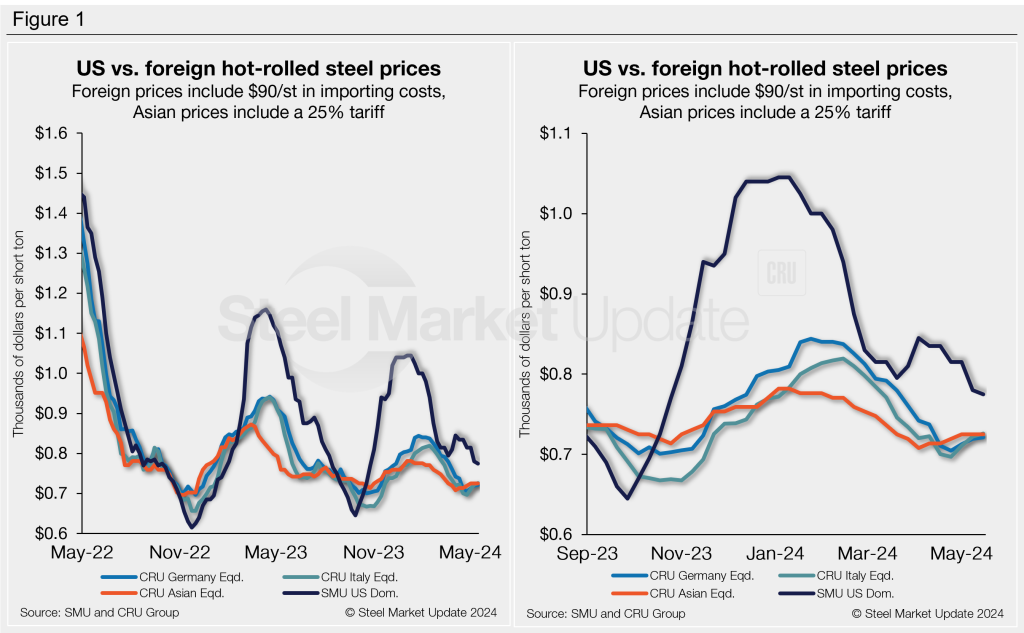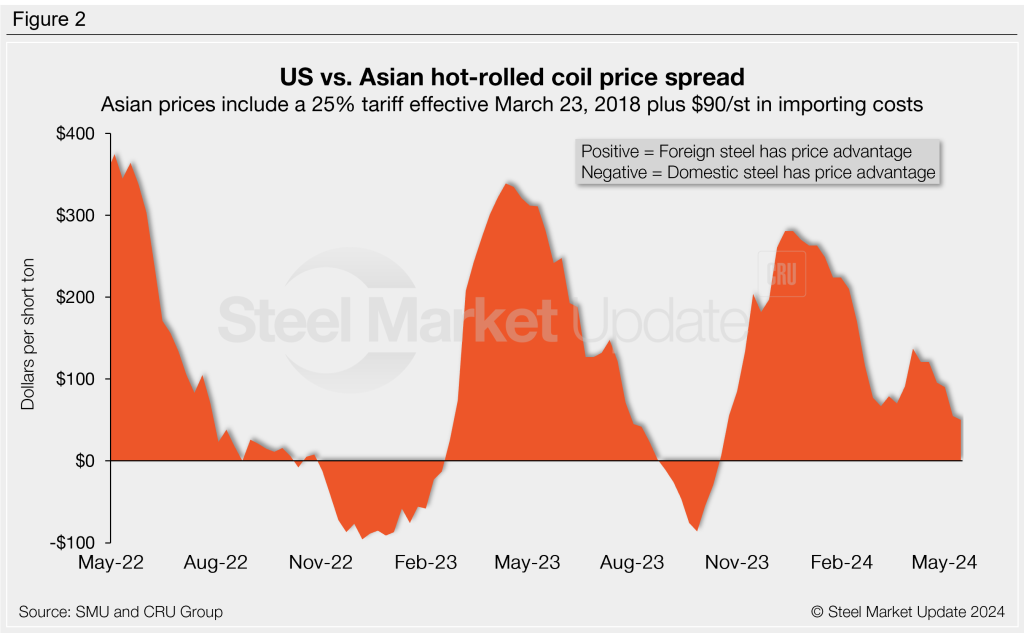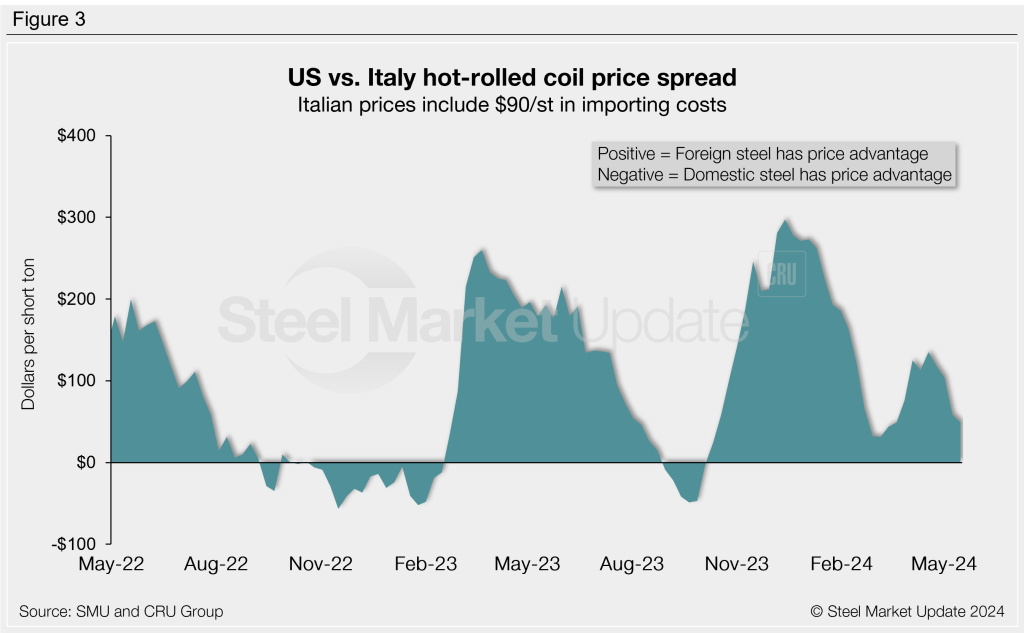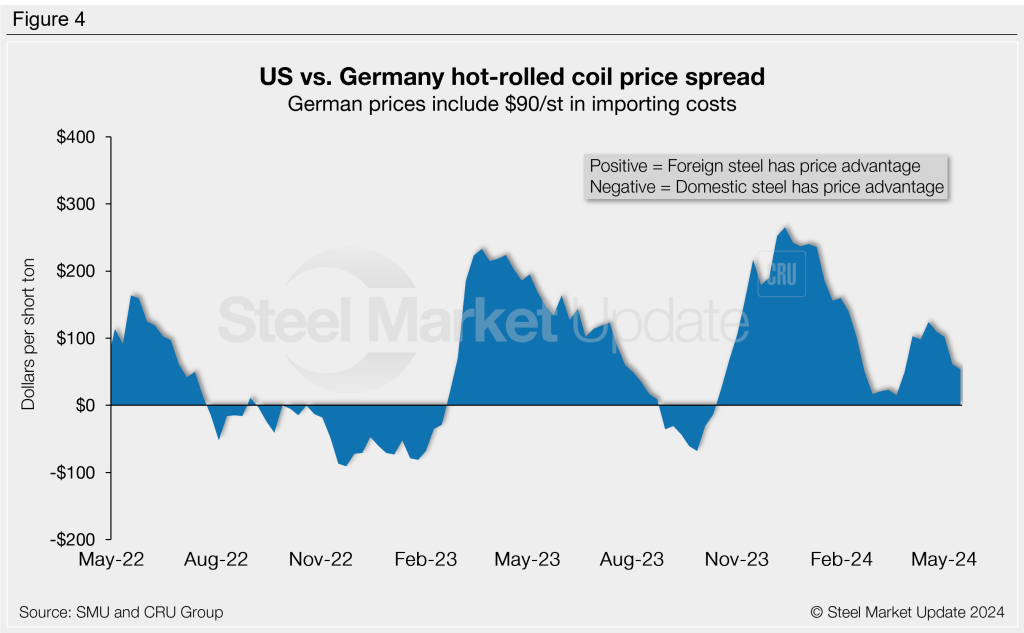SMU Data and Models

Foreign HR import appeal shrinks as US prices ease
Written by Brett Linton
May 16, 2024
US hot-rolled (HR) coil prices saw further declines this week, while foreign prices were steady to slightly higher in the three regions we monitor. As a result, the competitiveness of foreign HR coil to US buyers continues to decrease.
On average, domestic HR prices are now just 6% more expensive than imported material. This theoretical foreign discount has been declining over the past five weeks, now over half of what it was one month ago but not quite as low as we saw back in March.
Recall that we saw significant foreign discounts towards the end of last year when imports from certain regions held a theoretical discount of nearly $300 per short ton (st). This discount rapidly diminished and nearly disappeared by March.
US HR coil is now $51/st more expensive on average than imported material. This rate is down $7/st week on week (w/w) and $76/st less than levels one month ago. Looking back to mid-March we saw average spreads of $40-49/st.
Figure 1 below compares HR price indices for various regions. The graph on the left shows a two-year snapshot, while the right graph zooms in on the last few months.

Methodology
In this theoretical analysis we compare SMU’s US HR coil weekly index to the CRU HR coil weekly indices for Germany, Italy, and East and Southeast Asian ports. We add $90/st to all foreign prices to account for freight costs, handling, and trader margin. This gives us an approximate CIF US ports price to compare against domestic prices. We do not include any antidumping (AD) or countervailing duties (CVD) in this analysis. Buyers should use our $90/st figure as a benchmark and adjust up or down based on their own costs. If you import steel and would like to share your experience with importing costs, please reach out to info@steelmarketupdate.com.
Asian HRC (East and Southeast Asian ports)
As of today, May 16, the CRU Asian HRC price held steady from last week at $508/st, one of the highest prices seen since late-March. Adding a 25% Section 232 tariff and $90/st in estimated import costs, the delivered price of Asian HRC to the US is approximately $725/st.
Based on SMU’s check of the market on Tuesday, domestic HR coil prices fell to $775/st on average this week, down $5 w/w.
Therefore, domestic HRC is theoretically $50/st or 6% more expensive than steel imported from Asia. This price gap is down $5/st w/w and now the narrowest spread seen in almost six months. Recall that Asian HR recently held potential discounts of $200/st or more in December and January.

Italian HRC
Italian HR coil prices rose to a seven-week high of $636/st this week, up $4/st w/w. After adding import costs, the delivered price of Italian HR coil is in theory $726/st.
That means domestic HR coil is theoretically $49/st or 6% more expensive than steel imported from Italy, $9/st lower than last week. This spread has shrunk each of the past four weeks, following a 10-week high of $135 one month ago. Like the Asian spread, Italian prices had held a significant price advantage over US steel a few months ago, reaching a 22-month high of almost $300/st in mid-December.

German HRC
CRU’s German HR coil price rose $2/st from the week before to $631/st. After adding theoretical import costs, the delivered price of German HR coil is $721/st.
In theory, domestic HR coil is $54/st, or 7%, more expensive than HR coil imported from Germany. The spread is down to a seven-week low, having reached $124/st one month prior. Recall that just six months ago German HR coil held theoretical discounts of $265/st from domestic steel, a near two-year high.

Notes: Freight is important in deciding whether to import foreign steel or buy from a domestic mill. Domestic prices are referenced as FOB the producing mill, while foreign prices are CIF the port (Houston, NOLA, Savannah, Los Angeles, Camden, etc.). Inland freight, from either a domestic mill or from the port, can dramatically impact the competitiveness of both domestic and foreign steel. It’s also important to factor in lead times. In most markets, domestic steel will deliver more quickly than foreign steel.

Brett Linton
Read more from Brett LintonLatest in SMU Data and Models

SMU Survey: Sheet lead times ease further, plate hits one-year high
Steel buyers responding to this week’s SMU market survey report a continued softening in sheet lead times. Meanwhile, plate lead times have moderately extended and are at a one-year high.

SMU Survey: Buyers report more price flexibility from mills
Nearly half of the steel buyers responding to this week’s SMU market survey say domestic mills are showing increased willingness to negotiate pricing on new spot orders. This marks a significant shift from the firmer stance mills held in prior weeks.

SMU Survey: Buyers’ Sentiment Indices fall
Current Sentiment Index dropped six points to +42 this week compared to two weeks earlier. It has fallen in every successive survey since reaching a 2025 high of +66 on Feb. 19.

March service center shipments and inventories report
Steel service center shipments and inventories report through March 2024.

Apparent steel supply contracts in February
The amount of finished steel that entered the US market in February receded from January’s peak, according to our analysis of Department of Commerce and American Iron and Steel Institute (AISI) data.
